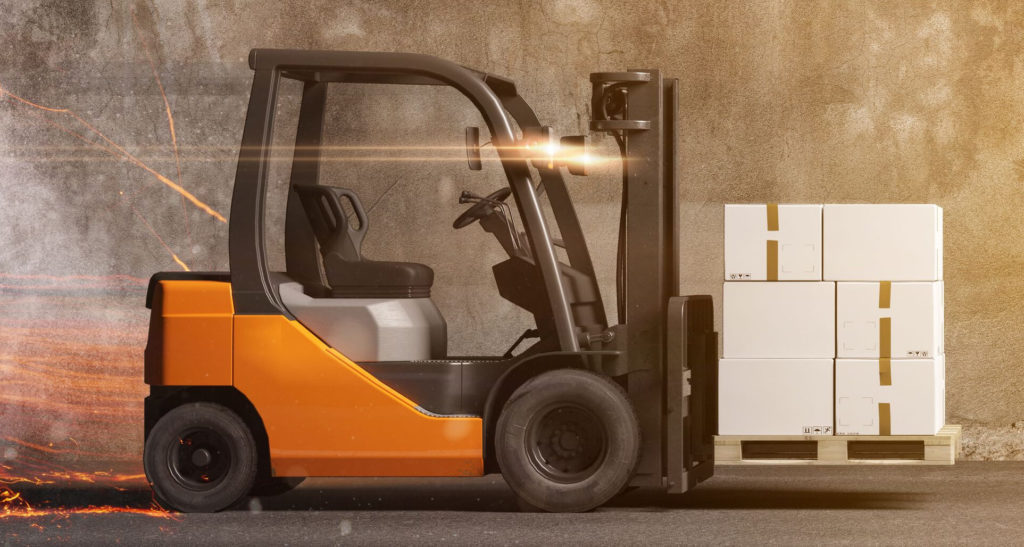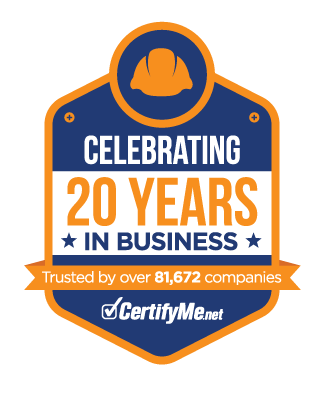Forklift Speed Limits and Safe Navigation: OSHA Guidelines You Need to Know
Posted by: admin on March 22, 2025

Efficient material handling depends on operating forklifts at appropriate speeds. Adhering to established guidelines enhances workplace safety and minimizes accident risks. Regulations set by OSHA stress controlled navigation to prevent collisions and maintain stability. Enrolling in OSHA forklift training ensures operators understand speed compliance while improving maneuvering skills.
OSHA Guidelines for Forklift Speed Limits
Rules governing forklift movement prioritize adaptability over rigid speed thresholds. Workplace conditions dictate appropriate speeds rather than universal limits. Regulations such as 29 CFR 1910.178(n)(8) require controlled stops. In comparison, 29 CFR 1910.178(n)(15) mandates reducing velocity when approaching intersections or limited-visibility areas.
Typical Speed Recommendations:
- Indoor warehouses: 3–5 mph for confined spaces
- Outdoor operations: 5–8 mph to accommodate terrain variations
- Loading docks: 2–3 mph for controlled movement near edges
Pedestrian-heavy areas: 2 mph or lower to enhance safety
Factors Influencing Safe Forklift Speeds
Navigating job sites at controlled speeds requires understanding key influencing factors.
Equipment Type
Electric forklifts generally operate at lower speeds, averaging 8 mph. Diesel-powered models reach up to 18 mph, requiring additional precautions in high-traffic areas.
Environmental Conditions
Surface materials and terrain affect vehicle control:
- Smooth, dry flooring allows standard speeds
- Slippery or wet surfaces necessitate reduced movement
- Rough terrain demands slower operation to prevent instability
- Inclined pathways require careful speed management
Load Characteristics
Transporting materials affects vehicle stability:
- Heavier loads necessitate slower speeds for safe braking
- Taller items require careful navigation to prevent tipping
- Wide loads demand cautious cornering to maintain control
- Unevenly distributed weight increases the risk of imbalance
Best Practices for Forklift Navigation
Operating at controlled speeds improves efficiency while preventing workplace accidents.
Turning Corners
- Reduce speed before initiating a turn
- Use a wide turning radius for stability
- Keep loads positioned close to ground level
- Maintain awareness of overhead clearance
Intersection Safety
- Sound the horn before entering blind spots
- Follow posted speed limits within enclosed spaces
- Look in both directions before proceeding
- Keep a safe stopping distance from obstacles
Transporting Loads
- Balance materials before initiating movement
- Maintain forks approximately six inches above the flooring
- Ensure visibility by securing an unobstructed line of sight
- Travel within designated lanes to avoid collisions
Determining Safe Stopping Distances – How OSHA Forklift Speed Limits Impact Safety
Stopping distances are related to the top speed of a forklift. Safe stopping distances are affected by several factors. These include the weight of the truck, weight of the load, and floor grading. The following formula is often used for calculation purposes:
S = 0.394^2 / D-G where:
- D = drawbar drag, as a percentage
- G = percentage grade (e.g., 5 for 5%)
- S = stopping distance in meters
- V = velocity in km/h
This helps set maximum speeds on clean, well-maintained floors. It also shows how work site factors, such as floor surface, drawbar drag and grade percentage, can impact safe speeds.
Common Forklift Speed Violations and How to Avoid Them
Speed-related infractions compromise workplace safety. Identifying violations helps reinforce responsible driving habits.
Frequent Issues
- Excessive acceleration in narrow aisles
- Taking corners too quickly
- Making sudden stops without warning
- Failing to reduce speed in congested areas
Prevention Strategies
- Display speed limit signage in high-traffic locations
- Install monitoring systems to track vehicle movement
- Conduct safety briefings to reinforce best practices
- Use floor markings to define designated travel paths
How to Calculate Safe Stopping Distance Based on the Top Speed of a Forklift
How fast can forklifts go? Forklift speed all depends on the type of forklift, the manufacturer’s guidelines, and other factors. We recommend that every employee should know the top speed of a forklift, regardless of the model they’re driving.
| Speed (km/h) | 6 | 12 | 14 | 16 | 18 | 20 | 22 |
| Speed in meters per second | 1.7 | 3.3 | 3.9 | 4.4 | 5 | 5.6 | 6.1 |
| Distance travelled while driver reacts to emergency (m) | 2.5 | 5 | 5.8 | 6.7 | 7.5 | 8.3 | 9.2 |
| Minimum Theoretical Emergency Stopping Distance (m) | 2.8 | 6 | 7 | 8.5 | 9.5 | 11 | 12.5 |
| Minimum Actual Emergency Stopping Distance – test results (m) | 2.9-3.2 | 7-8 | 8-10 | 9.5-12 | 11-14 | 13-16.5 | 14.5-19 |
How to Control Forklift Speed
Operators are responsible for driving at safe forklift speeds. Here are things you can do to promote safe forklift driving across your jobsite:
 Post forklift speed limit signs where operators can easily see them. These serve as constant reminders to maintain safe speeds.
Post forklift speed limit signs where operators can easily see them. These serve as constant reminders to maintain safe speeds.- Install forklift speed bumps. These help control speed by forcing trucks to come to a complete stop to pass over them. Place them in crosswalks, pathways, blind spots and areas with pedestrian traffic.
- Install speed limiting devices on your forklifts. These prevent operators from speeding by controlling the truck’s throttle system. They do not reduce the full lifting power of the truck.
- Equip your forklifts with speed alarms. These alert operators when they go over the speed limit. Forklift speed alarms can be set up to create beeps when the forklift approaches the speed limit. When the operator exceeds the speed limit, the alarm will flash warning lights or create a loud siren noise.
It’s one thing to set truck speed limits. To have a safe worksite, you also need to make operators aware of the limits and enforce them.
Forklift Safety Best Practices
Enforcing forklift speed limits is a good start to avoid tip-overs and other types of lift accidents. You can also ensure that your workers use the following forklift safety best practices:
- Always operate forklifts at a speed that allows stopping in a safe and controlled manner.
- Drive slowly and with caution on wet, slippery floors.
- Always watch your forklift max speed, and run your lift within allowable forklift speed limits.
- Use extra caution on-ramps and graded surfaces.
- Slow down and sound your horn when navigating intersections and blind spots.
- Reduce speed around corners by turning the steering wheel in a smooth, sweeping motion
- Keep a reasonable distance between forklifts.
Other Factors to Consider When Determining Safe Forklift Speeds
Forklifts come in different sizes and weights. They also have different construction materials. You must be aware of these differences to operate the vehicle safely. The heavier the vehicle, the lower the speed should be.
You must also take into account the condition of the aisles where the trucks circulate. The surface resistance and anti-slip ability will determine how far the truck will need to brake. Another important factor is driver visibility. Driving speed should be slower in areas of poor visibility.
Ramps, curves, and road obstacles should be considered when determining driving speed. The truck must go slower on a ramp with a higher inclination. Quick turns should always be avoided
Once we figure out how fast people should go in each case, we need to make sure everyone follows the speed limit. We need to talk to employees about this goal and remind drivers by posting signs with the speed limit at regular intervals.
Advances in Electric Forklift Speed Control Technology
More and more employers have begun searching for ways to limit forklift speed in the workplace. Electric forklift speed control offers a number of benefits. There are two kinds of drive speed controls: AC and DC. The DC system allows operators to apply a certain voltage to the DC motor to operate the lift, while the AC option allows for more variable speed control technology. Given this versatility, it’s no wonder electric forklifts are growing in popularity.
Frequently Asked Questions About Forklift Speed Limits
How fast can a forklift legally go?
Forklift speed varies depending on site conditions, equipment type, and load weight. Most facilities limit forklifts to a maximum speed of 10 mph.
Does OSHA have a specific maximum speed limit?
OSHA has not established a universal speed cap. Instead, employers must define safe operational limits according to workplace conditions.
What is a safe speed in a warehouse environment?
Standard recommendations suggest maintaining speeds between 3–5 mph and adjusting downward in high-traffic zones.
Do forklifts have speed governors?
Yes, various devices limit movement. Speed restrictors prevent excessive acceleration, while GPS monitoring systems track real-time velocity.
Elevate Workplace Safety with CertifyMe
Protecting workers starts with enforcing proper speed management. Combined with structured training, regulatory compliance minimizes risks and enhances operational efficiency. CertifyMe offers OSHA-compliant forklift certification programs designed to reinforce safe driving techniques. Ensure workplace readiness today—explore certification options and build a safer job site.
Welcome to CertifyMe.net
CertifyMe.net has offered online forklift certification since 1999. With Our Convenient online program. your employess can earn their certification in an hour or less.
Browse Online Certifications:
This low-cost program can be compeleted anytime, anywhere!






